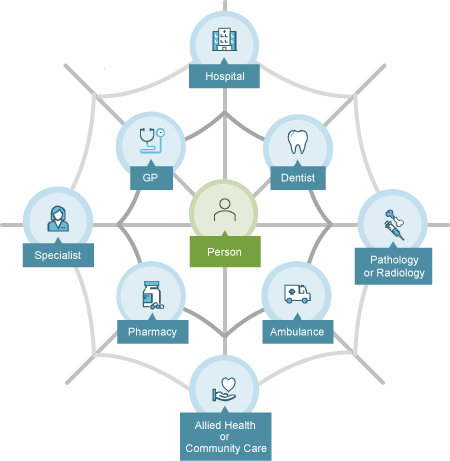WORKING GROUP DRAFT – IN CONFIDENCEReport on Government Services 2026
PART E: RELEASED ON 5 FEBRUARY 2026
E Health
Data downloads
These data tables relate to the sector as a whole. Data specific to individual service areas is in the data tables under the relevant service area.
![]() Health data tables (XLSX 437.9 KB)
Health data tables (XLSX 437.9 KB)
Refer to the Sector overview text and corresponding table number in the data tables for detailed definitions, caveats, footnotes and data source(s).
Note: Data tables are referenced by table xA.1, xA.2, etc, with x referring to the section or overview. For example, table EA.1 refers to data table 1 for this sector overview.
Main aims of services within the sector
The main objective of the health sector is that Australians are born and remain healthy. To this end, health sector services seek to promote, restore and maintain a healthy society through the delivery of services that prevent illness, promote health, detect and treat illness and injury, rehabilitate and provide palliative care.
In Australia, the health sector consists of four main services.
Primary and community health
Primary and community health services aim to promote health, prevent illness and support people to manage their health issues in the community. These include general practice, pharmaceutical services, dentistry, allied health services, community health services, maternal and child health and alcohol and other drug treatment.
- Total government real recurrent expenditure on primary and community health services was $50.3 billion in 2022-23.
- There were 29,215 full-time equivalent (FTE) general practitioners (GPs), equating to 109.7 per 100,000 people nationally in 2023.
- Around 226 million services were subsidised under Section 85 and Section 100 of the Pharmaceutical Benefits Scheme (PBS) in 2023-24.
Ambulance services
Ambulance service organisations are the primary agencies involved in providing emergency medical care, pre-hospital and out-of-hospital care, and transport services.
- Total government real recurrent expenditure on ambulance services was $5.9 billion in 2023-24.
- Total ambulance service organisation revenue was $5.6 billion in 2023-24.
- There were 25,345 registered paramedics in Australia in 2023-24.
- There were 5.8 million ambulance responses to 4.4 million incidents in 2023-24.
Public hospitals
Public hospitals aim to alleviate or manage illness and the effects of injury by providing acute, non and sub-acute care along with emergency and outpatient care.
- Total government real recurrent expenditure on public hospitals (excluding depreciation) was $96.1 billion in 2022-23.
- There were 700 public hospitals in Australia in 2022-23, comprising 65,051 public hospital beds (equivalent to 2.5 beds per 1,000 people).
- Approximately 7.1 million separations from public (non-psychiatric) hospitals in 2022-23.
Services for mental health
Services for mental health aim to promote mental health and wellbeing, and where possible prevent the development of mental health problems; and when mental health problems and illness do occur, reduce their impact.
- Total government real recurrent expenditure allocated to mental health services was $12.6 billion in 2022-23.
- A further $5.3 billion was provided to support people with a significant and enduring primary psychosocial disability through the National Disability Insurance Scheme (NDIS) in 2022-23.
- 12.6 million Medicare-subsidised services for mental health were provided in Australia in 2023-24. This includes Medicare-subsidised mental health services provided by primary and community health providers, state and territory government specialised mental health services and non-government services providing community-based support.
Detailed information on the equity, effectiveness and efficiency of service provision and the achievement of outcomes for the primary and community health, ambulance services, public hospitals, and mental health services is contained in the service-specific sections.
Government expenditure in the sector
Total government recurrent expenditure for health services for the latest years covered in this report was $152 billion.
For the 2022‑23 financial year (the most recent financial year for which data are available across all sections) this represented 40.7% of total government expenditure covered in this report.
As much of the expenditure on services for mental health is already captured in public hospital and primary and community health expenditure, it is not included in the health sector expenditure total to avoid double counting.
Flows in the sector
Health services in Australia are delivered by a variety of government and non‑government providers in a range of service settings that do not have a clearly defined path (figure E.1).
Figure E.1 Client flow within the Australian health care system

Intersection of ambulance services and public hospital emergency departments
The intersection of ambulance services and public hospital emergency departments (EDs) is a vital component of the healthcare system, facilitating patients receiving timely and effective emergency care. Efficient ambulance-to-ED transfers ensures timely treatment, prevents complications, and maintains emergency service capacity (Dawson et al. 2022).
Delays in transfers may disrupt patient care and limit ambulance and ED response capabilities, increasing strain on the health system (Mengyu et al. 2019). Delays may result from hospital overcrowding, partly a consequence of increasing presentations to EDs (AIHW 2025a; Crawford et al. 2014). Long-stay patients awaiting discharge can further reduce hospital capacity and delay admissions from the ED (IFEM 2020). Limited aged care and disability support services, along with staff and resource shortages may compound the issue (Kruk 2023; Queensland Health 2024).
Governments are working to minimise patient transfer delays to provide immediate medical care for lower acuity patients and divert unnecessary presentations from EDs (DHAC 2023; Savira et al. 2025). For example:
- Medicare Urgent Care Clinics aim to ease the pressure on hospitals and give patients more options to see a health care professionals when they have an urgent, but not life threatening, need for care.
- 'Hospital in the Home’ programs provide hospital-level care at home also aim to increase availability of hospital beds by reducing demand (Montalto et al. 2020).
- Virtual Emergency Department care provides urgent medical care remotely, particularly for conditions that are not life-threatening. These services allow patients to connect with emergency-trained health professionals via telehealth, potentially avoiding the need to visit a physical ED.
These measures diversify the care settings available to patients and provide an alternative to public hospital-based care, thus increasing hospital capacity and reducing patient transfer delays.
This overview provides selected population health insights across four themes:
- Babies born of low birthweight
- Selected potentially preventable diseases
- Life expectancy
- Mortality rates.
Babies born of low birthweight
In 2022, 5.1% of babies born in Australia were of low birthweight (table EA.1). Nationally, the proportion of babies born of low birthweight to Aboriginal and Torres Strait Islander mothers was more than twice that for babies born to non-Indigenous mothers (figure E.2).
Further information on the historical and ongoing context for Aboriginal and Torres Strait Islander people is available on the Closing the Gap Information Repository website – Target 2
Selected potentially preventable diseases
Selected potentially preventable diseases are diseases that could potentially have been prevented through the provision of health interventions and early disease management. Diseases covered in this report include selected cancers, heart attacks and type 2 diabetes.
- Nationally in 2021, the age standardised rate of new cases of selected cancers was highest for female breast cancer (123.3 per 100,000 females), followed by melanoma, bowel cancer and lung cancer (49.1, 47.7 and 40.9 per 100,000 people, respectively) and lowest for cervical cancer (7.1 per 100,000 females) (table EA.11).
- Nationally in 2022, the age standardised rate of heart attacks (acute coronary events) was 266.9 cases per 100,000 people aged 25 years or over (table EA.14). The national rate has decreased each year over the 10 years included in this report. The rate for females is less than half the rate for males.
- Nationally in 2022, an estimated 4.5% of adults had type 2 diabetes (table EA.16).
Life expectancy
Historically, life expectancy has risen steadily over time but has decreased in recent years. In 2021–23, life expectancy at birth was 81.1 years for males and 85.1 years for females – slightly lower than 2020–22 (table EA.20). The life expectancy of Aboriginal and Torres Strait Islander people is considerably lower than that of other people, with a life expectancy at birth of 71.9 years for Aboriginal and Torres Strait Islander males and 75.6 years for Aboriginal and Torres Strait Islander females born between 2020–22 (table EA.21).
Further information on the historical and ongoing context for Aboriginal and Torres Strait Islander people is available on the Closing the Gap Information Repository website – Target 1
Mortality rates
The national age standardised mortality rate was 512.9 deaths per 100,000 people in 2023 – a decrease from 2022 (figure E.3). In line with life expectancy data, mortality rates are higher for Aboriginal and Torres Strait Islander people compared to non-Indigenous people (table EA.23).
Child mortality
Mortality data is separately reported for children as follows:
- Registered perinatal deaths, comprising fetal deaths (stillbirths) and neonatal deaths (death of an infant within 28 days of birth)
- Registered infant deaths (children aged less than 1 year)
- Registered infant and child deaths (children aged 0–4 years).
Registered perinatal, infant and child deaths data are sourced from the Australian Bureau of Statistics (ABS) Causes of Death collection, which is based on information from births, deaths, and marriage registrars. Further information on hospital recorded perinatal deaths is available from the Australian Institute of Health and Welfare (AIHW) National Perinatal Mortality Data Collection (2024).
Nationally, in 2023:
- there were 8.2 registered perinatal deaths per 1,000 births (table EA.32), of which around 72.2% were fetal deaths and the remainder neonatal deaths (table EA.30–31)
- the average infant mortality rate was 3.2 registered deaths per 1,000 live births (table EA.26). Over the past 10 years, the average infant mortality rate has ranged from 3.1 (2016 and 2018) to 3.4 (2014) registered deaths per 1,000 live births.
The Australian infant and child combined mortality rate (3-year average) has decreased over time from 82.5 deaths per 100,000 population in 2012–14 to 74.5 deaths per 100,000 population in 2021–23 (table EA.28).
Causes and prevention
The most common causes of death among all Australians in 2023 were neoplasms (cancer) and circulatory diseases (including heart disease, heart attack and stroke) (table EA.24). Data by Indigenous status is available in table EA.25.
There is potential to prevent some deaths through individualised care and/or to treat health conditions through existing primary or hospital care.
- Nationally, there were 97.2 potentially avoidable deaths per 100,000 people in 2023 – a decrease on 2022 (101.8 per 100,000 people) (table EA.17).
- The rate of potentially avoidable deaths in 2019–23 for Aboriginal and Torres Strait Islander people was 301.0 per 100,000 people – the highest rate over the reported time series (since 2017–21) and more than three times the rate for other Australians (94.5) (table EA.18).
Data on key risk factors affecting population health outcomes (including overweight or obesity, smoking and risky alcohol consumption) are available in tables EA.3–10. In summary, nationally in 2022:
- 33.7% of adults were overweight, while 31.1% were obese – a decrease and increase, respectively, since 2017-18. Additionally, 19.5% of children aged 5–17 years were overweight, while 8.3% were obese – an increase since 2017-18 (table EA.3).
- 10.7% of Australians reported that they were current daily smokers, the lowest proportion recorded in the time series (since 2007-08) (table EA.6).
- 12.9% of Australians exceeded the alcohol lifetime risk guidelines (as defined by the 2009 National Health and Medical Research Council [NHMRC] guidelines) – the lowest proportion recorded in the time series (since 2007-08) (table EA.8).
Data on key risk factors affecting Aboriginal and Torres Strait Islander people is available in tables EA.30-33. Nationally in 2022-23:
- 74.5% of Aboriginal and Torres Strait Islander people over the age of 18 reported being overweight or obese (table EA.30)
- 32.5% of Aboriginal and Torres Strait Islander people reported that they smoke daily, the lowest proportion recorded in the time series (since 2004-05) (table EA.31)
- rates of long-term risky alcohol consumption have reduced to 17%, the second lowest proportion in the time series behind 2014-15 (15.8%) (table EA.32)
Further information on the historical and ongoing context for Aboriginal and Torres Strait Islander people is available on the Closing the Gap Information Repository website – Target 1
Health workforce
The health care workforce is essential to the health system’s function, providing care, supporting public health efforts, and ensuring operational continuity. Nationally in 2023:
- there were 118,937 FTE medical practitioners. There were 762 medical practitioners who identified as Aboriginal and Torres Strait Islander, an increase of 19% compared to 2022 (table EA.34).
- there were 358,705 FTE nurses and midwives, the seventh consecutive increase over a seven-year period (table EA.35)
Data for allied health professionals, dentists and allied dental workers is available in tables EA.36-38.
A summary of the primary and community health, ambulance services, hospitals and mental health services performance indicator results are presented. Detailed information is in the service-specific sections.
- Delaying seeing a GP or filling a prescription due to affordability concerns has become more common.
Nationally in 2023-24:- 8.8% of respondents who needed to see a GP reported that they delayed or did not see a GP in the last 12 months due to cost, the highest over the reported time series. This proportion is an increase on 2022-23 (7.0%) and continues a year-on-year increase since 2020-21 when the proportion was 2.4%
- 8.0% of respondents who needed a prescription for medication reported that they delayed filling or did not fill a prescription in the last 12 months due to cost, the highest over the reported time series. This proportion is an increase on 2022-23 (7.6%) and continues a year-on-year increase since 2020-21 when the proportion was 4.4%.
- Breast cancer screening rates have not returned to pre-pandemic levels.
The national age-standardised BreastScreen participation rate for women aged 50–74 years for 2022–2023 was 51.2%, an increase from 2021–2022 (49.5%). While screening rates have increased, they have not returned to pre-pandemic levels (54.2% in 2018–2019).- For 2022–2023, the participation rate for Aboriginal and Torres Strait Islander women aged 50–74 years was 35.8%, also an increase from 2021–2022 (33.5%), although notably lower than the screening rates for all women.
- Workforce sustainability measures have deteriorated.
Nationally in 2023:- 26.6% of FTE GPs were aged 60 years or older, compared to 1.5% who were less than 30 years of age. This is the equal highest proportion of GPs aged 60 years or older and the lowest proportion of GPs who were less than 30 years old across the reported nine-year time series
- the proportion of GPs who exited the GP workforce was 1.4%, with the proportion highest for those 60 years and over (2.7%) – the highest since 2019 (when this statistic was first reported).
More information: section 10 Primary and community health
- Ambulance response times across Australia improved for the majority of jurisdictions compared to previous years.
All jurisdictions except the Northern Territory and Tasmania recorded shorter response times compared to previous years. In 2023-24:- the time within which 90% of first responding ambulance resources arrived at the scene of an emergency in code 1 situations ranged from 16.7 minutes (Australian Capital Territory) to 36.0 minutes (Tasmania) state-wide
- for the Northern Territory, the time within which 90% of first responding ambulance resources arrived at the scene of an emergency in code 1 situations increased from 25.7 minutes in 2022-23 to 31.1 minutes in 2023-24, state-wide
- the time within which 50% of first responding ambulance resources arrived at the scene of an emergency in code 1 situations ranged 9.9 minutes (Western Australia and Australian Capital Territory) to 14.9 minutes (Tasmania) state-wide.
- Nationally, the proportion of patients who reported a clinically meaningful pain reduction was the lowest recorded.
‘Pain management’ is defined as the proportion of patients who report a clinically meaningful reduction in pain severity. Patients who refuse pain medication are excluded from reporting. Nationally in 2023-24:- the proportion of patients who reported clinically meaningful pain reduction at the end of ambulance service treatment was 82.5%. This continues a year-on-year decrease since 2019-20 and is the lowest recorded proportion over the 10-year time series.
- Nationally, cardiac arrest survival rates improved compared to the prior year.
‘Cardiac arrest survival rate’ is defined as the proportion of adult patients (aged 16 years and over) who were in out‑of‑hospital cardiac arrest and returned to spontaneous circulation (that is, the patient had a pulse) on arrival at hospital. Nationally, in 2023-24:- the cardiac arrest survival rate for paramedic witnessed cardiac arrests was 49.3% nationally (up from 45.8% in 2022-23)
- the cardiac arrest survival rate for non-paramedic witnessed cardiac arrests where resuscitation was attempted was 25.3% (up from 23.5% in 2022-23).
More information: section 11 Ambulance services
- Almost all category 1 patients were seen within clinically appropriate timeframes. However, the proportion of patients seen within clinically appropriate timeframes across all triage categories remains lower than it has been over the time series.
In 2023-24:- all category 1 patients (need for resuscitation) were seen within clinically appropriate timeframes in New South Wales, Victoria, Queensland and Tasmania, but 2% in South Australia, 1% in Western Australia and the Australian Capital Territory and 20% in the Northern Territory were not seen immediately.
- the proportion of category 2 patients (emergency) seen within 10 minutes was 67% – a decrease over the past 10 years from 79% in 2014-15
- for all triage categories combined, an estimated 67% of patients were seen within triage category timeframes – a decrease over the past 10 years from 74% in 2014-15.
- Waiting times for admitted patients have shown some improvements but they remain higher than they have been over the time series.
In 2023-24:- 50% of patients were admitted within 46 days (down from 49 days in 2022-23) and 90% of patients were admitted within 329 days (down from 361 days in 2022-23). While showing some improvement in recent years, waiting times for admitted patients remain notably higher than they were ten years ago (35 days for 50% of patients and 253 days for 90% of patients in 2014-15)
- 31% of people who presented to an emergency department and were admitted, waited four hours or less to be admitted to a public hospital; consistent with results for 2022-23 and notably lower than the proportion in 2019-20, which was 46%).
- Adverse events continue to occur across Australian public hospitals at a similar rate.
‘Adverse events treated in hospitals’ are incidents in which harm resulted to a person during hospitalisation and are measured by separations that had an adverse event (including infections, falls resulting in injuries and problems with medication and medical devices) that occurred during hospitalisation.- Nationally in 2022-23, 6.4% of separations in public hospitals had an adverse event reported during hospitalisation (equivalent to the result for 2021-22).
- Workers aged 60 years and over, and workers aged under 40 years, make up an increasing proportion of the nursing and medical practitioner workforces.
Nationally, across all areas in 2023:- 8.4% of the FTE nursing workforce was aged 60 years and over. Since 2014, the proportion of nurses and midwives aged under 40 years of age has increased by 11.4 percentage points
- the attrition rate for nurses and midwives was 28.9% (a decrease from 31.0% in 2022)
- the proportion of the medical practitioner workforce aged 60 years and over across all areas was 5.8%. Unlike the nursing workforce, the proportion of the medical practitioner workforce aged under 40 years has remained around 61% since 2014
- the attrition rate for medical practitioners was 22.9% (a decrease from 26.6% in 2014).
More information: section 12 Public hospitals
- Delaying seeing a mental health professional due to affordability concerns has become more common.
Nationally, in 2023-24, 20.4% of all respondents delayed seeing any mental health professional in the last 12 months due to cost, continuing a year on year increase over the available time series (up from 12.0% in 2020-21).- Respondents were almost two and a half times as likely to report delaying mental health care due to cost for psychologists, psychiatrists and other mental health professionals (24.6%) than for GPs (10.3%).
- The proportion of mental health-related presentations to emergency departments that were seen within clinically recommended waiting times has decreased.
- Nationally, in 2022-23, 59.0% of people who presented to an emergency department with a mental health-related care need were seen within clinically recommended waiting times, 9.0 percentage points less than in 2016-17.
- Follow-up rates after psychiatric admission/hospitalisation have improved over the past decade.
- Nationally, the rate of community follow-up for people within the first seven days of discharge from an acute inpatient psychiatric unit was 76.2% in 2022-23, an increase over the 10 years from 2013-14 (67.4%).
More information: section 13 Services for mental health
References
ABS (Australian Bureau of Statistics) 2025, National Aboriginal and Torres Strait Islander Health Measures Survey, https://www.abs.gov.au/statistics/people/aboriginal-and-torres-strait-islander-peoples/national-aboriginal-and-torres-strait-islander-health-measures-survey/latest-release (accessed XX October 2025)
AIHW (Australian Institute of Health and Welfare) 2025a, Emergency department presentations - Hospitals, Australian Institute of Health and Welfare, https://www.aihw.gov.au/hospitals/topics/emergency-departments/presentations (accessed 13 June 2025).
AIHW (Australian Institute of Health and Welfare) 2025b, National Perinatal Mortality data collection, https://www.aihw.gov.au/about-our-data/our-data-collections/national-perinatal-mortality-data-collection-npmdc (accessed 18 October 2024).
Crawford, K, Morphet, J, Jones, T, Innes, K, Griffiths, D and Williams, A 2014, ‘Initiatives to reduce overcrowding and access block in Australian emergency departments: A literature review’, Collegian, vol. 21, no. 4, pp. 359–366.
Dawson, LP, Andrew, E, Stephenson, M, Nehme, Z, Bloom, J, Cox, S, Anderson, D, Lefkovits, J, Taylor, AJ, Kaye, D, Smith, K and Stub, D 2022, ‘The influence of ambulance offload time on 30‐day risks of death and re‐presentation for patients with chest pain’, Medical Journal of Australia, vol. 217, no. 5,
DHDA (Australian Government Department of Health Disability and Ageing) 2023, About Medicare Urgent Care Clinics, Australian Government Department of Health and Aged Care, https://www.health.gov.au/find-a-medicare-ucc/about (accessed 28 May 2025).
IFEM (International Federation for Emergency Medicine) 2020, Report from the Emergency Department Crowding and Access Block Task Force, June.
Kruk, R 2023, Independent review of Australia’s regulatory settings relating to overseas health practitioners, Special Inquiry.
Mengyu, L, Vanberkel, P and Carter, AJE 2019, ‘A review on ambulance offload delay literature’, Health Care Manag Sci, Health care management science, vol. 22, no. 4, https://pubmed.ncbi.nlm.nih.gov/29982911/ (accessed 20 May 2025).
Montalto, M, McElduff, P and Hardy, K 2020, ‘Home ward bound: features of hospital in the home use by major Australian hospitals, 2011-2017’, The Medical Journal of Australia, vol. 213, no. 1, pp. 22–27.
Queensland Health (The State of Queensland) 2024, Understanding ambulance ramping and why it happens, Queensland Health, https://www.health.qld.gov.au/newsroom/features/understanding-ambulance-ramping-and-why-it-happens (accessed 20 May 2025).
Savira, F, Frith, M, Aditya, CJ, Randall, S, White, N, Giddy, A, Spark, L, Swann, J and Robinson, S 2025, ‘Urgent care centres for reducing the demand on emergency departments’, Medical Journal of Australia (MJA), vol. 222, no. 9, https://apo.org.au/node/330747 (accessed 28 May 2025).
Victorian Auditor-General’s Office 2024, Access to Emergency Healthcare, https://www.audit.vic.gov.au/report/access-emergency-healthcare/?section=34689--what-we-found (accessed 20 May 2025).
We value your comments about this publication and encourage you to provide feedback.





